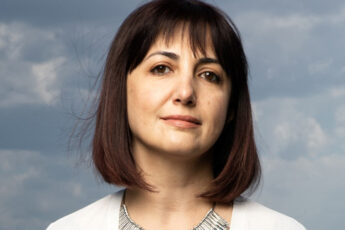
Ola Jankowska’s body-drama Anatomy is a confident first feature. Both stylized and slow, the film is drenched in deep melancholy. Yet another promising debut from Poland, Anatomy screened at the 18th Giornate degli Autori in Venice last year and at this year’s Golden Apricot Yerevan International Film Festival. In Jankowska’s film, nothing really happens; the story is told through gestures and gazes, silence and breath. Mika (Karolina Kominek), thirty-something, returns to Poland to see her father (Andrzej Poniedzielski), who is in hospital with brain damage. Revisiting old friends in Warsaw, she embarks on an internal road trip into the past. As her father’s memory fades, Mika begins to find herself.
Anatomy is a hypnotic study of identity and grief. Digital and archival footage, VHS and infrared recordings are blended into a stream of consciousness by editor Mateusz Romaszkan. In its mixed-media nostalgia, the film calls to mind Jacqueline Lentzou’s Moon, 66 Questions (2020). Just like Lentzou’s protagonist Artemis, Mika returns home after living abroad to visit her sick father and the remains of a previous life. It is worth pointing out that, despite their different contexts, the two directors rewrite this age-old tale of homecoming in similar ways, with both drawing attention to society’s fragmentation and the erosion of traditional values.
Warsaw in winter is a nightmare of glass and concrete. Archival material of the city, interspersed throughout Mika’s bleak present, recalls the disastrous destruction in the war and its Communist past. What remains from the monstrous twentieth century are not traces but mere surface. Małgorzata Szyłak’s cinematography is very beautiful throughout, if her play with reflections and double images is somewhat clinical at times. The bleak city is another protagonist in Anatomy, a blurred background in blue, grey, and white that has a claustrophobic feel to it.
The camera stays skin-to-skin with Mika, who is by turns tender and detached. We rarely see her face or the ones around her; instead, the focus is on bodies, often captured from behind as they cover most of the screen. Mika gradually uncovers fragments from a forgotten past, a process as painful as her father’s decline. Very little is directly expressed; like in a contemporary Noh play, the actors convey feelings through symbolic, slow gestures. The effect of this performance is a perturbing sense of alienation. More important than dialogue is the atmospheric sound design. While there’s no music, except in a bar scene, Anatomy uses natural sounds of birds, respiration and traffic, if in an amplified and distorted fashion.
After a while, the viewers immerse themselves into this sad dream world. One particularly touching scene of loneliness is Mika’s encounter with her first boyfriend. We only hear her voice without seeing any faces; the camera focuses on the changing scenery outside the car window. Driving around the city with him, she recalls how she imagined their life together, confessing that he was her first love. There is no reply; he keeps driving in silence. Then some time passes before she finally leaves the car. From this point onward, the film breathes a sense of absolute disconnectedness. In Jankowska’s world, no more words are left after memories have vanished.
While bearing its very own hallmarks, Anatomy also belongs to a remarkable new wave of female directors from Poland, including Jagoda Szelc, Aga Woszczynska or Agnieszka Smoczyńska (whose 2018 film Fugue also features a daughter who returns home). One signature of this new wave is a strangely somatic film language. It’s not a cinema of ideas but of our concrete existence in the world. Navigating the balance between hyperrealism and magical elements, Jankowska’s body-cinema dissects our experience, breaking it down to its smallest elements. In Anatomy, these are the heart, blood, spine, stomach, and lastly death (these elements also serve as the film’s intertitles, providing each vignette with a theme). Watched along with Woszczynska’s dark, pitch-perfect debut Silent Land (2021), Anatomy is a more formally experimental film that tends to remain at the surface instead of going under the skin. However, its hypnotic dream world and adventurous style make Jankowska’s debut a remarkable study of loss and alienation.




Leave a Comment